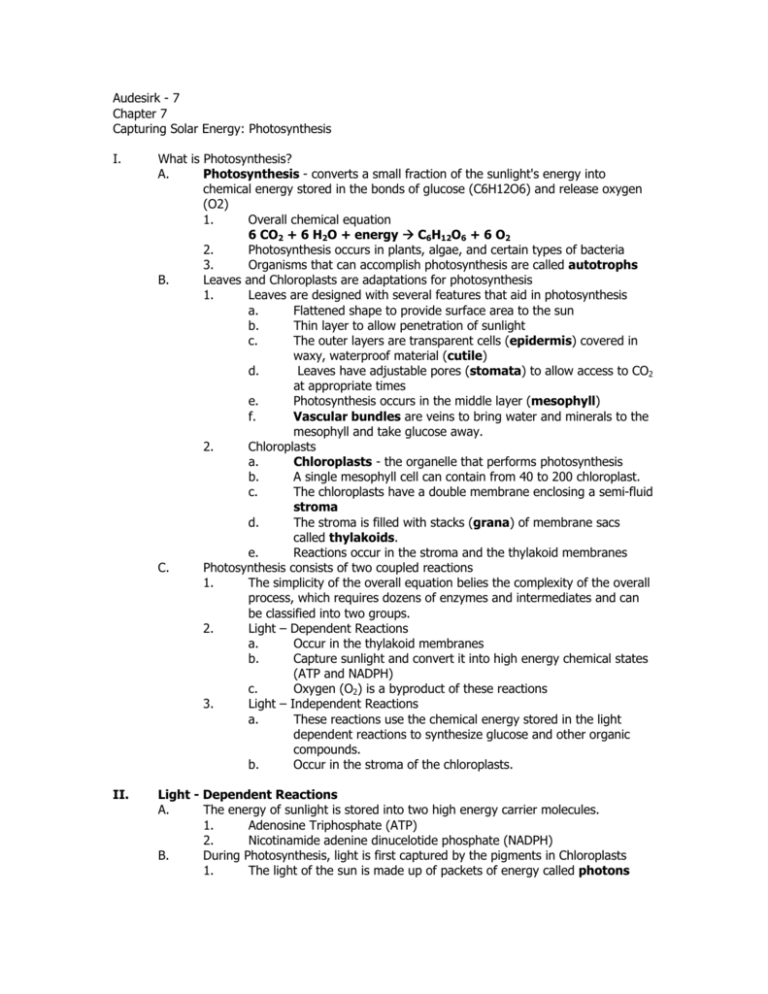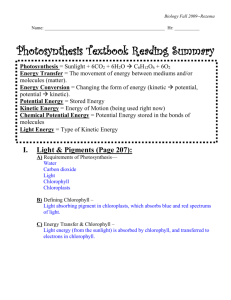Audesirk - 7 Chapter 7 Capturing Solar Energy: Photosynthesis I
advertisement

Audesirk - 7 Chapter 7 Capturing Solar Energy: Photosynthesis I. What is Photosynthesis? A. Photosynthesis - converts a small fraction of the sunlight's energy into chemical energy stored in the bonds of glucose (C6H12O6) and release oxygen (O2) 1. Overall chemical equation 6 CO2 + 6 H2O + energy Æ C6H12O6 + 6 O2 2. Photosynthesis occurs in plants, algae, and certain types of bacteria 3. Organisms that can accomplish photosynthesis are called autotrophs B. Leaves and Chloroplasts are adaptations for photosynthesis 1. Leaves are designed with several features that aid in photosynthesis a. Flattened shape to provide surface area to the sun b. Thin layer to allow penetration of sunlight c. The outer layers are transparent cells (epidermis) covered in waxy, waterproof material (cutile) d. Leaves have adjustable pores (stomata) to allow access to CO2 at appropriate times e. Photosynthesis occurs in the middle layer (mesophyll) f. Vascular bundles are veins to bring water and minerals to the mesophyll and take glucose away. 2. Chloroplasts a. Chloroplasts - the organelle that performs photosynthesis b. A single mesophyll cell can contain from 40 to 200 chloroplast. c. The chloroplasts have a double membrane enclosing a semi-fluid stroma d. The stroma is filled with stacks (grana) of membrane sacs called thylakoids. e. Reactions occur in the stroma and the thylakoid membranes C. Photosynthesis consists of two coupled reactions 1. The simplicity of the overall equation belies the complexity of the overall process, which requires dozens of enzymes and intermediates and can be classified into two groups. 2. Light – Dependent Reactions a. Occur in the thylakoid membranes b. Capture sunlight and convert it into high energy chemical states (ATP and NADPH) c. Oxygen (O2) is a byproduct of these reactions 3. Light – Independent Reactions a. These reactions use the chemical energy stored in the light dependent reactions to synthesize glucose and other organic compounds. b. Occur in the stroma of the chloroplasts. II. Light - Dependent Reactions A. The energy of sunlight is stored into two high energy carrier molecules. 1. Adenosine Triphosphate (ATP) 2. Nicotinamide adenine dinucelotide phosphate (NADPH) B. During Photosynthesis, light is first captured by the pigments in Chloroplasts 1. The light of the sun is made up of packets of energy called photons a. C. Photons vary in energy, and these different energy levels have different colors, from ultraviolet, through the visible spectrum down to infrared. b. The photons in the visible spectrum (the familiar rainbow of colors you know) are at the right energies to affect the pigments of plants and yet not permanently damage them. c. When these photons hit an object one of three things will happen i. Absorption – the photon can be absorbed by the material, either heating it or fueling a reaction. ii. Reflection – the photon is bounced off, these reflected photons can be absorbed by our eyes to allow us to perceive color iii. Transmitted – the photon can pass through the material unchanged iv. Important – note that the color of a material is based on the energies reflected or transmitted, not those that are absorbed… think about this in relation to the color of plants. 2. Chloroplasts contain a variety of pigments, each absorbing a slightly different wavelength (energy level for the photon) a. Chlorophyll – The key pigment in plants, it strongly absorbs blue, violet, and red light and reflects green light (hence the color of the pigment) i. Chlorophyll comes in two slightly differing forms: Chlorophyll a and Chlorophyll b. ii. Each of these has slightly different absorption spectrum iii. Land plants use Chlorophyll a as their primary pigment. b. Accessory Pigments – Secondary pigments in the chloroplasts that help to broaden the spectrum of absorbed light and funnel energy to the chlorophyll a molecules. i. Chlorophyll b ii. Carotenoids – accessory pigments that absorb mainly blues and greens, appearing red, yellow, and orange. a. Sometimes referred to as beta-carotene b. Their color is typically masked by chlorophyll (when do you see the color?) c. Principal source of vitamin A for humans, which is used for visual pigments. The light-dependent reactions occur within the thylakoid membranes 1. The thylakoid membranes have a highly organized set of proteins, chlorophyll, and accessory pigments, called photosystems a. There are thousands of copies of each of two separate photosystems. i. Photosystem I (PS I) ii. Photosystem II (PS II) b. The pigments gather laight and pass energy along to a specific pair of chlorophyll molecules in a small region of the photosystem, called a reaction center c. The reaction center is located next to an electron transport chain (ETC), a series of carrier molecules that capture excited electrons from the chlorophyll of the reaction center and cascade them down through a series of energy levels, capturing energy 2. 3. as this is done. PS II generates ATP a. Energy funneled into the reaction center excites two electrons in the chlorophyll molecules. These are passed to the ETC. b. The first carrier protein in the ETC accepts the energized electrons and starts passing them down through the chain. c. At each step down the chain some energy is lost in the electrons, while some is lost to heat (remember thermodynamics); some is captured to hydrogen ions (H+) across the membrane. d. The resultant hydrogen ion gradient is used to produce ATP through a process called chemiosmosis (we will descuss this process in detail later) e. The deenergized electrons (though still at a higher energy state than originally) are passed to the reaction center of PS I. PS I generates NADPH a. Energy funneled into the reaction center excites two electrons in the chlorophyll molecules. These are passed to the ETC. b. The first carrier protein in the ETC accepts the energized electrons and starts passing them down through the chain. c. The energy of the electrons is used to split a water molecule apart and to use the electrons and resultant hydrogen ion to make NADPH from NADP+ d. The resultant electrons released from the split water molecule are captured by PS II to replace its missing electrons and restart the cycle. III. Light-Independent Reactions A. The ATP and NADPH synthesized in the light-dependent reactions are dissolved in the stroma of the chloroplast. B. ATP and NADPH are used to drive the fixation of carbon from carbon dioxide into glucose. C. The light-independent reactions are only independent as long as there is ATP and NADPH, if the stores of these molecules drop then the reactions can not continue. D. The fixation of carbon is done through the Calvin-Benson Cycle (C3 Cycle) 1. Carbon Fixation – The CO2 molecules are bound to a five carbon sugar called ribulose bisphosphate (RuBP). These unstable six-carbon molecules are converted to short three carbon compounds called phosphoglyceric acid (PGA) 2. Synthesis of G3P – Numerous energy dependent reactions are used to convert PGA into glyceraldehyde-3-phosphate (G3P) 3. Regeneration of RuBP – Using more ATP, ten of the twelve G3P are used to regenerate the used RuBP, the remaining two G3P are used to synthesis glucose. 4. The G3P used for glucose formation is done with reactions that occur outside the chloroplast. IV. The relationship between the light-dependent and light-independent reactions. See Figure 7-7 V. Water, CO2 and the C4 Pathway A. Closed stomata and photorespiration 1. Photorespiration – the fruitless use of the carbon fixation pathways to try and fix O2 2. Photorespiration occurs when the supply of CO2 is cut off and the enzymes try to bind O2 to RuBP 3. This process occurs mainly in hot dry seasons when plants have to close their stomata to control water loss B. C4 Plants control photorespiration through a two-stage fixation process, which requires more energy to produce glucose. C. C3 and C4 plants are adapted to differing environments 1. Plants that use the C4 pathway are locked into that pathway and have to use more energy to produce the same amount of glucose. 2. C4 plants can only out-compete if the environment is normally hot and dry for a significant span of each growth season









